3 year old Raffles is ready to start his education – from scratch! This program combining, groundwork, lunge and liberty, will teach you how to build a solid foundation in preparation for backing. Follow each season and learn how to produce a relaxed, confident equine partner who enjoys working with you.
with Raffles
3 year old Raffles is starting his education. Follow each season and learn to build a solid foundation.
Scroll through each season!
Spring
Summer
Autumn
Winter
Spring Season
Raffles has just arrived - fresh out of the packet! We start by building rapport, and learning how to safely deal with spooky situations. We then introduce 'hand signals' ready for lunge work.
Download our quick reference cards for each lesson to keep you and your horse on track!
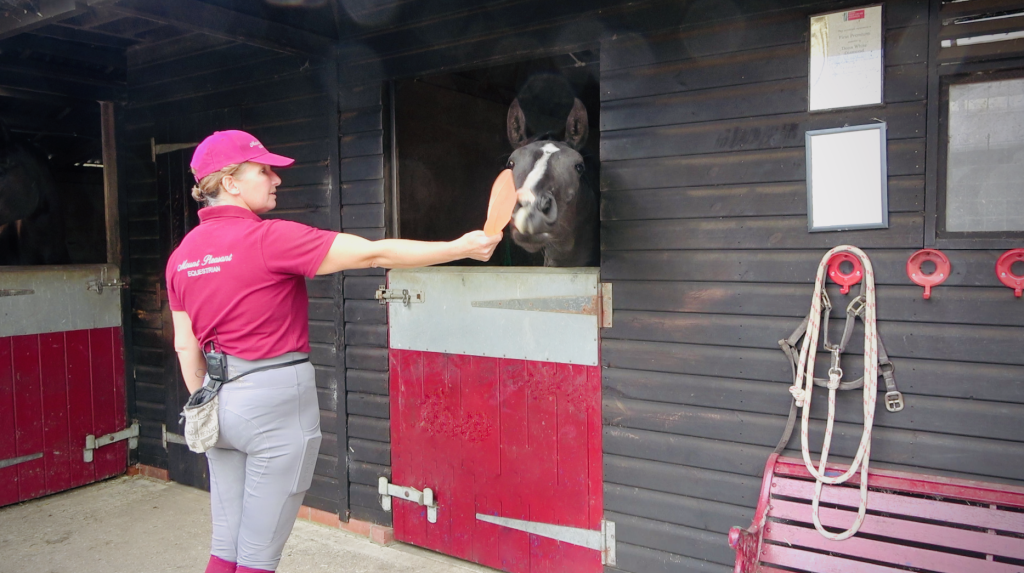
Spring: Lesson 1
Clear Communication
- Building rapport
- communication
- Using rewards
- Positive reinforcement
- Bolshy behaviour
- Foundation for lunge work
Learn how to communicate with your horse with this fun 'targeting' exercise.
How many times have you heard someone say ‘oh if only my horse could talk’! We might not be able to train your horse to say words but that doesn’t mean we can’t develop a language. So how do we do this? Well it starts with this fun simple ‘targeting’ exercise.
In this lesson we will teach Raffles how to 'target' a disk while safely behind the stable door. This exercise underpins our entire approach: to communicate clearly and effectively with your horse. Some people get a bit twitchy about using food as a reward as they are worried it might encourage bolshy behaviour. But this exercise trains the exact opposite! You will see that by only rewarding the behaviour that you want, your horse will quickly learn to eliminate unwanted behaviour. So your horse becomes respectful of your space, easy to handle and safe to manage.
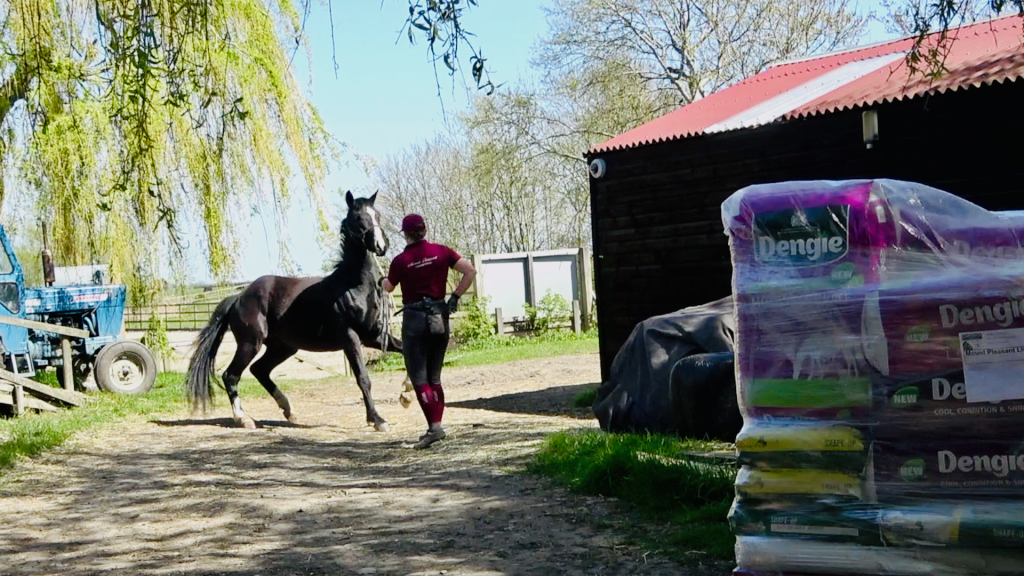
Spring: Lesson 2
Horse 'Self-management'
- Hand signals
- Head down
- Relaxation
- Spookiness
- Parasympathetic state
- Horse self-management
- Real life demonstration
Build in a 'reset button' to teach your horse to stay calm in any situation!
In the previous video Raffles learned to put his head down and touch a target on the ground. Next comes the clever part - we ‘overlay’ a hand signal so he learns when we point downwards, he puts head down. This is our cue to help him to 'reset' and stay calm.
This lesson is a real life demonstration of how brilliantly this works in practice. When a horse is frightened they are in ‘flight mode’ – blood rushes to the muscles, the back contracts, pupils are dilated and the head is raised. When a horse is calm it’s the opposite. They are in parasympathetic state - the back is un-contracted, eyes are soft and the head is down. By training them to put their head down we are helping them to stay in control. Instead of running away they have another option - put their head down, relax and learn better horse ‘self-management’.
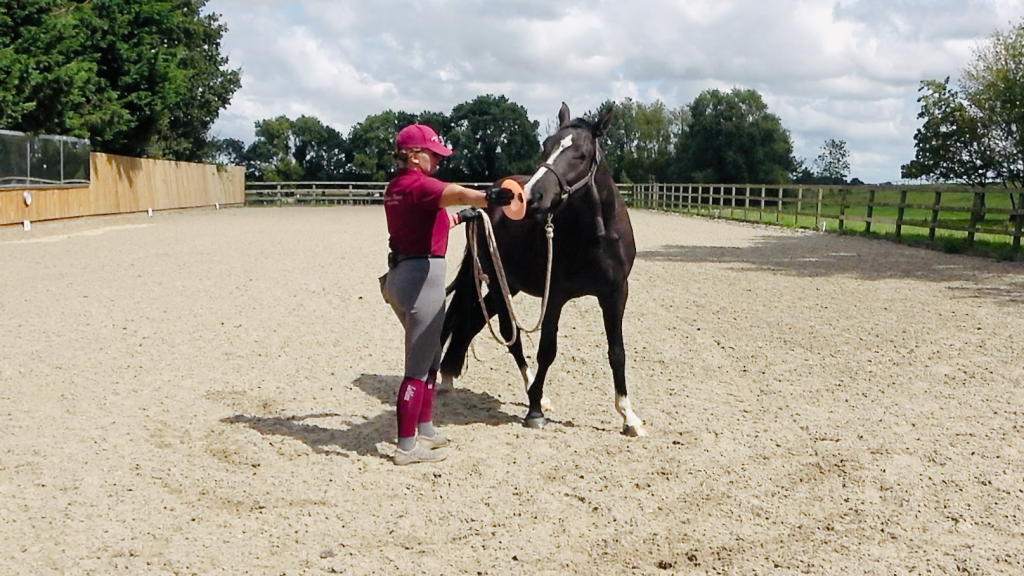
Spring: Lesson 3
Lunge Hand Signals
- Introducing lungework
- Hand signals
- Body language
- Clear communication
- Instant accurate feedback
You and your horse will learn to read 'hand signals' ready for lunge work.
In the first part of this lesson we use the target to teach Raffles the hand signal or 'cue' for lunge work. As we progress we then use the target to ‘lure’ him around a circle - just a few steps at first, then we slowly up the criteria as we progress to full circles. By reading our clear body language, clever Raffles is beginning to understand how to lunge.
By now you should be starting to see this program is more than a training system - it is a language. The 'TSK' sound is way of saying ‘Yes! that is what I want’. When you then add a combination of body language and hand signals or ‘cues’ we can communicate clearly with our horse, and give them instant accurate feedback. BTW… the reason we use this TSK sound is because it is short and sharp and importantly it is non emotional - it’s actually really hard to make it sound happy... or sad, so the sound you make is always consistent to your horse.
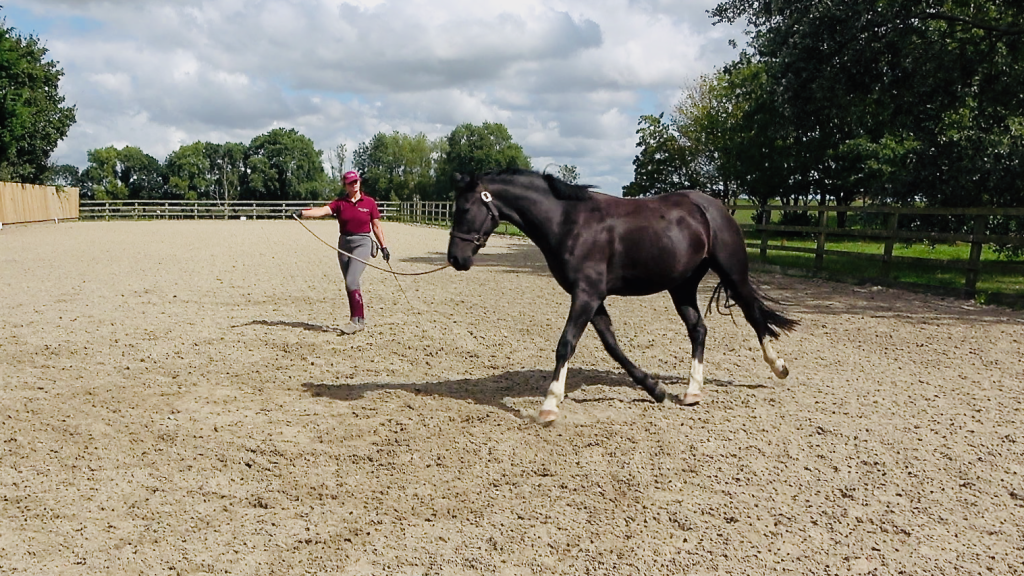
Spring: Lesson 4
The Language of Lunge
- Clear consistant cues
- Thinking in pictures,
- Flight animals
- Energy control
- Stop and go cues
- Hind quarter yield
Learn to control your body language and energy to communicate aids.
Horses ‘think in pictures’. In this lesson we lose the target, but the picture stays the same, with our arm pointing out 'like we’re directing traffic' in the direction we want Raffles to move in. Horses are acutely aware of other animals' body language, including us humans!
When we stand tall like a solider and take a breath in - we bring our energy up. If we relax, go all slouchy and exhale - we bring our energy down. Horses pick up on this and you will already instinctively adjust your energy around your horse without even realising it! As we progress we will switch our energy 'on and off' as an additional 'cue'. To go forward, we stand tall, breathe in - energy up. To stop we make ourselves smaller, exhale - energy down. At this point we will look for the inside hind leg to step under as the horse turns in and stops. This is a ‘hind quarter yield’ which you will see we'll be using a lot in this program.
Downloadable Quick-Reference Cards
Lesson:Clear Communication

Start by training your horse to ‘target’ over the stable door. Allow your horse to touch the cone with their nose - ‘tsk’ & reward.

Stand approximately 2m away with your arm outstretched - ‘tsk’ & reward when your horse touches the target ‘like a button’.

Once consistent, move your arm to your right side, and then your left side. Repeat each side 3 or 4 times.

Next stand your horse on the yard or the arena. Place the target on the ground where your horse can easily see it.

As your horse puts their head down towards the target, point downwards to overlay your hand cue - ‘tsk’ & reward as they touch the target.
REMEMBER:
Your horse is only allowed to touch the target - there is no reward for touching you! This will teach your horse to respect your boundaries.
Your horse is only allowed to touch the target - there is no reward for touching you! This will teach your horse to respect your boundaries.
- Spring
Summer Season
Hello sunshine! In this season your horse will learn how to 'mirror' your body language so that transitions become light and balanced, and the lunge work will continue to progress beautifully.
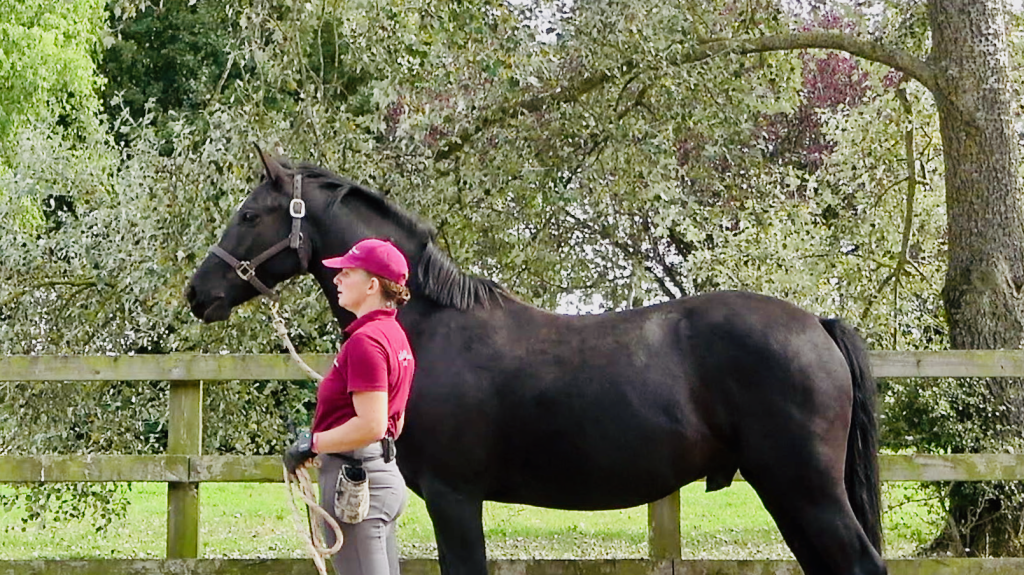
Summer: Lesson 1
Light Transitions
- Calm and safe handling
- Respecting boundaries
- Focus
- Lightness
- Balance
- Sharp reactions
- Preparation for riddenwork
This lesson will train your horse to focus and respect your boundaries.
Most people don’t give 'leading' their horse much thought, but it is amazing how much you can achieve with this simple exercise. Training your horse to 'mirror' your body language helps them to learn to keep their focus on you. Raffles is already learning that a clear arm signal pointing forwards means 'go’. He has to pay attention and move off smartly. Equally he is also learning that when we stop abruptly 'like a soldier' he must immediately halt. He must not get heavy and plough forwards!
This exercise is helping him learn to respect boundaries so that he is easy to handle. Every time we make a transition we are gradually training him shift his balance towards his hind quarters so we are getting that beautiful feeling of 'lightness' which is also important preparation for the riddenwork.

Summer: Lesson 2
Transitions on Lozenge
- Lightness
- Transitions
- Lozenge shape
- Turn about the fore
- Square halts
- Superstitious behaviour
Once you can 'go & whoa' next learn to 'turn on the fore' and square halt.
In the previous lesson we trained Raffles to 'go & whoa' on a circle. Next we take in more of the arena, working on a 'lozenge' shape. When we change rein we learn to use 'turn about the fore' which is a brilliant exercise in itself with lots of key benefits to help your horse later on in their training. Finally we start to tidy up our halt transitions teaching Raffles to square up his front feet.
An important lesson to learn as a trainer is to filter out behaviour you don’t want. So if your horse starts asking questions; 'what do you want me to do? Is it a head down, or it it maybe pawing the ground?', it’s important to try to stay 'neutral'. So remember to focus what you WANT your horse to do, rather than what you DON'T WANT. Eventually they will join up the dots you can see Raffles quickly learns to square his front feet consistently.

Summer: Lesson 3
Lunge Control Walk
- Falling in
- Confidence
- Natural asymmetry
- Hind quarter yield
- Staying in control
Learn to sustain a steady walk rhythm and keep your horse out on a circle.
The aim for this lesson is to progress the lunge work keeping a nice steady walk pace and we also need to keep Raffles' feet out on the track so that our 20m circle is as big as possible. Although this lesson may seem very simple, it is important to take the time to master it - especially before you add the rider.
Pay attention to your own body language, and be mindful of your energy - if your horse breaks into trot learn to exhale bringing your 'energy down', and calmly stay in control of the situation. Think of it as a rehearsal. We need to practice so that if a mistake does happen we can use the 'hind quarter yield' to quietly come back to walk. It shouldn’t feel like you are walking on egg shells - you should feel 100% confident at all times in order to keep your rider safe and set your horse up for success.

Summer: Lesson 4
Lunge Control Trot
- Rider safety
- Falling in
- Natural asymmetry
- Balance
- Confidence
Next progress to trot - notice which rein your horse is more confident.
In this lesson you will see how Raffles finds the trot work easy on the left rein, but he 'falls in' on the right, making the circle too small. If your horse is ‘crowding you’ there are two reasons why this could be. Firstly, horses are less confident on their right side so they want to cling near you on the right rein. Secondly, your horse may fall in due to lack of balance caused by natural asymmetry.
At this young age most horses are asymmetrical in their body and limbs, in other words they are slightly banana shaped, so they find it difficult to move on circles. This is why we start on the ground and practise without the extra weight of the rider. If we miss out this step and the circle gets too small and tight, when you then have a rider on board, your horse may lose balance and feel vulnerable… so they become tense and may hit the eject button!
Downloadable Quick-Reference Cards
Lesson:Light Transitions

Start by increasing the size of your ‘safe zone’ adding a 3rd cone to the previous triangle set up. You will now be working on a circle.

Lead your horse around the circle using a clear signal for ‘go’ - rope arm outstretched forward. If your horse doesn’t tap behind you with the whip.

To ‘whoa’ - bring your energy up and stop abruptly at the marker like a soldier. Each time you cue your horse to ‘go’ and to ‘whoa’ - ‘tsk’ and reward.

If your horse doesn’t stop, use the whip like a window wiper to block them. Repeat the lesson on both reins.

To change rein, ‘turn about the fore’. Move between the fence and your horse. Point the whip at the hind, and step the hind around to turn 180 degrees.
REMEMBER:
The aim is to train your horse to mirror your body language to keep their focus on you and to achieve ‘lightness’.
The aim is to train your horse to mirror your body language to keep their focus on you and to achieve ‘lightness’.
- Summer
Autumn Season
Raffles is getting his furry coat! This season we focus on learning basic figures, your horse will become fitter and more balanced as they sustain the trot, and we have fun working in liberty.
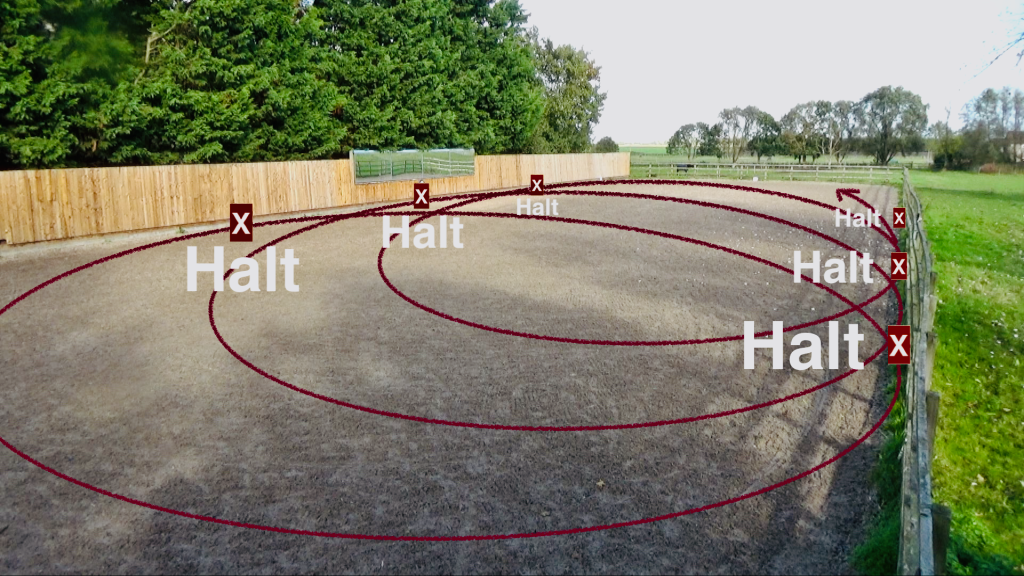
Autumn: Lesson 1
Corkscrew Pattern
- Corkscrew pattern
- Transitions
- Staying out on track
- Confidence
- Preparation for tuning in to rider
Corkscrews are not only for opening wine - they also develop balance!
In the previous season we taught Raffles to halt at two markers either side of a 20m circle on the track. In this exercise we will move the circle up the arena, adding in halt transitions at markers on the track as we go along. We will then repeat this pattern working back down the arena again in a ‘corkscrew shape’.
This pattern will not only help Raffles to stay on the track, instead of falling in, but it will also help him feel more confident and relaxed when moving freely around the arena. You will see we will start to be able to step further away towards the centre line so that when it comes to adding the rider, your horse will be prepared and ready to start 'tuning in' to the rider, rather than falling in or clinging on to the handler on the ground.
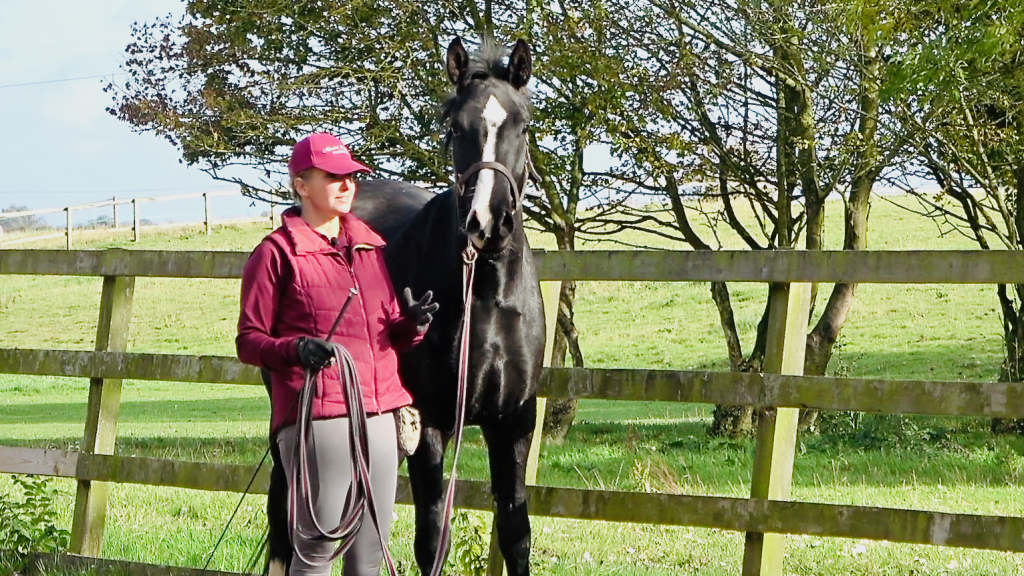
Autumn: Lesson 2
Sustaining Trot
- Sustaining trot
- Self-carriage
- Fitness
- Scales of training
- Balance confidence
- Relaxation
- Rhythmical trot beat
Raffles is gradually building up fitness and sustaining a lovely rhythm.
In the previous lesson we started moving our the circle up the arena, in a ‘corkscrew pattern’, adding in halt transitions at markers on the track. In this exercise we are aiming to 'sustain the trot' and make a continuous corkscrew pattern, without the halts. As we start to sustain the trot, Raffles will build up fitness, learn to balance, and develop a rhythm in the trot.
Remember the scales of training - we are aiming to develop a good rhythmical trot beat. In order to achieve this your horse must be relaxed, confident and balanced, not struggling or falling in like a drunken sailor! Build up the exercise gradually - adding in halts as you need them to take a breather or if you feel there is a loss of balance or confidence and any point.

Autumn: Lesson 3
Basic Liberty Walk
- Basic liberty
- Visceral learning
- Tuned in
- Connection
- No lunge line
- Maintain direction
- Control pace
- Blind spot
Unclip the lunge line! This introduction to liberty is hugely beneficial and fun.
In this lesson we start playing with liberty training where the horse is totally free - there’s no lunge line! To begin with, we need to 'check in' with Raffles. We start on a small circle so that we can gauge just how 'tuned-in' he is. Our priority at this stage is to maintain the connection and check that he remembers the 'visual cues' he has learned previously.
Learning is visceral for horses, in other words, their reactions are based on their emotions rather than reason or thought. So don't be offended if at first, your horse decides to leave the party! It's ok - they are just testing their boundaries. You can stay in control by maintaining the direction, controlling the pace, and moving into the 'blind spot' which encourages your horse to turn. Like Raffles, your horse will soon learn the best place to be to rest and relax is next to you!

Autumn 4: Lesson
Basic Liberty Trot
- Basic liberty trot
- Rhythm
- Suppleness
- Lateral bend
- Hind quarter yield
- Reward with rest
- Balance
- Motivation
- Connection
You and your horse will soon be addicted to 'liberty' work - guaranteed!
In this video, we build on the previous exercise and progress to liberty trot work. We start 'tuning in' in walk first working on a 'figure of 8' pattern using our 'hind quarter yield'. Then we ask for just a few trot steps, and reward. Gradually we build to a quarter circle, then half and then a full circle. When you are training, remember to build up the exercises slowly. Be patient. It’s important not to suddenly expect three circles from your horse.
It’s amazing to see Raffles' progress. Soon he is working in trot in a beautiful rhythm on a 20m circle - with no lunge line attached! The only thing keeping him with Tracy is his mind and the beautiful connection they have. It is his choice to stay rather than leave, so we must remember to allow frequent rest breaks to keep him motivated and connected.
Downloadable Quick-Reference Cards
Lesson:Corkscrew Pattern

First remind your horse where they need to halt, at the 1st marker at one end of the arena - ‘tsk and reward. Then start in trot on the lunge.

As your horse approaches the 1st marker, bring your energy down - ‘tsk’ the moment your horse’s feet touch the track at the marker. Halt and reward.

Next, using your clear consistent cues, walk to the next marker and halt again - ‘tsk’ and reward. Then trot a 20m circle and repeat the step above.

Continue working your way up, and back down the arena. Notice how your horse starts ‘seeking’ out the markers. Repeat on both reins.

This pattern will help your horse learn to stay out on the track, and it will also help them feel con fi dent working around the whole arena.
REMEMBER:
If your horse is feeling fresh or fi dgety, they may need to do some trot before you start adding in the halts in this lesson.
If your horse is feeling fresh or fi dgety, they may need to do some trot before you start adding in the halts in this lesson.
- Autumn
Winter Season
Christmas is coming and so is the canter work! The best gift of all is our beautifully trained, confident young horse, who enjoys their work. Wow, what an adventure!

Winter: Lesson 1
Shoulder Control
- Turning aids
- Yielding
- Whip aid
- Influencing the shoulder
- Ground poles
- Neck bend
- Falling through shoulder
There is a famous saying; ‘To control the shoulders is to control the horse’.
When we start learning to ride, most of us are taught to 'pull on left rein to turn left', and 'pull on the right rein to turn right'. But this is problematic! When you train a young horse, or any horse for that matter, as it is so important that the horse trusts your hands. If you pull on the inside rein to turn your horse, the bit will be pulling at an angle in the mouth, the neck will bend and they will fall out through the shoulder. Your horse will then lose balance and confidence… and everything starts to unravel.
In this lesson we are going to teach Raffles the correct turning aids from the ground keeping the neck straight and turning or 'yielding' the outside shoulder around the circle. This is called 'shoulder control'. How do we do that? As always we start on the ground, this time using poles as a guide.
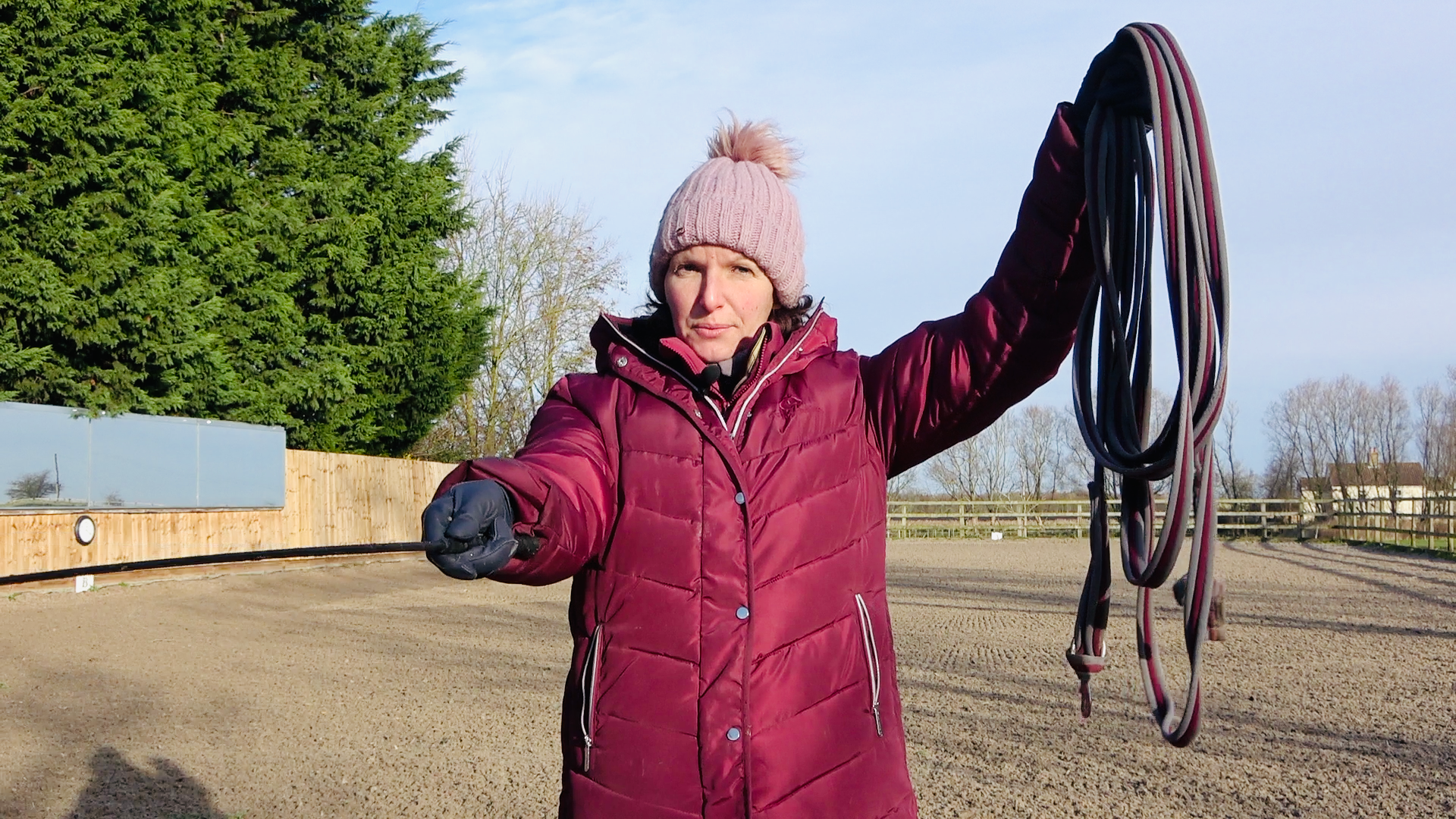
Winter: Lesson 2
Canter Transition
- Learning by repetition
- Balance
- Body language
- Consistent cues
- Body posture and energy
- Lightness
- Responsiveness
Learn how to set up canter transitions and develop responsiveness.
Let’s recap on what we’ve learned so far - we have ‘stop and go’, we stay out on the circle so no falling in, shoulder control, beautiful trot work moving around the whole arena, and we can even unclip the lunge line and have a play in liberty! This is a good solid foundation so now we’re ready to start to canter.
We start on a 20m circle at A. The reason for this is that we have 3 sides of the arena to help to turn - so you don’t end up pulling on your horse's face and upsetting their balance. Ask for the canter transition on the open side of the circle aiming for the same point each time so your horse learns by repetition. Once you have established a good trot, bring your energy up, check your posture, then raise your ‘rope’ hand, point the whip at the withers and ‘cluck’ once - don’t 'cluck cluck cluck' like a chicken!
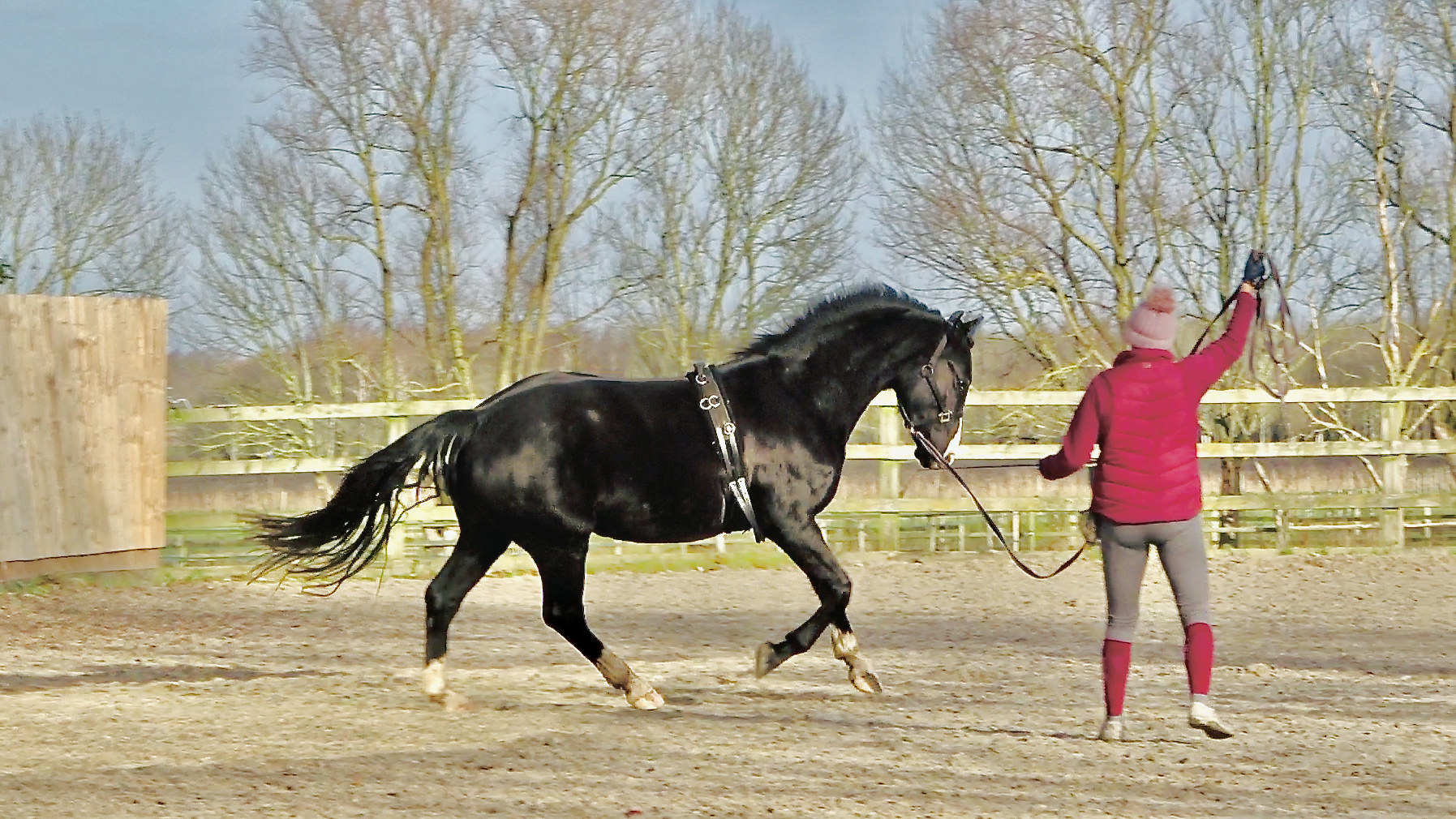
Winter: Lesson 3
Sustaining Canter
- Sustaining canter
- Self-carriage
- Engagement
- Balance
- Lightness
- Transitions
- Nagging
If you are doing more work than your horse, you need to learn this lesson!
Once we have established the canter transition we’re ready for the next stage which is to start 'sustaining the canter'. Our aim is to start as we mean to go on, with your horse learning to stay in canter by themselves without you having to keep nagging!
The key thing here is once you make the transition, remember to come back to ‘neutral’ with your cues - so bring your arm down and let the whip just hang low so your horse can see a clear difference in your body language - that’s really important. At first your horse won’t understand and they will make the mistake of breaking into trot. Allow this mistake to happen, then simply give the cue for the canter transition again - and come back to neutral. Soon your horse will learn to stay in the canter by themselves, without you having to chase after them the whole time!
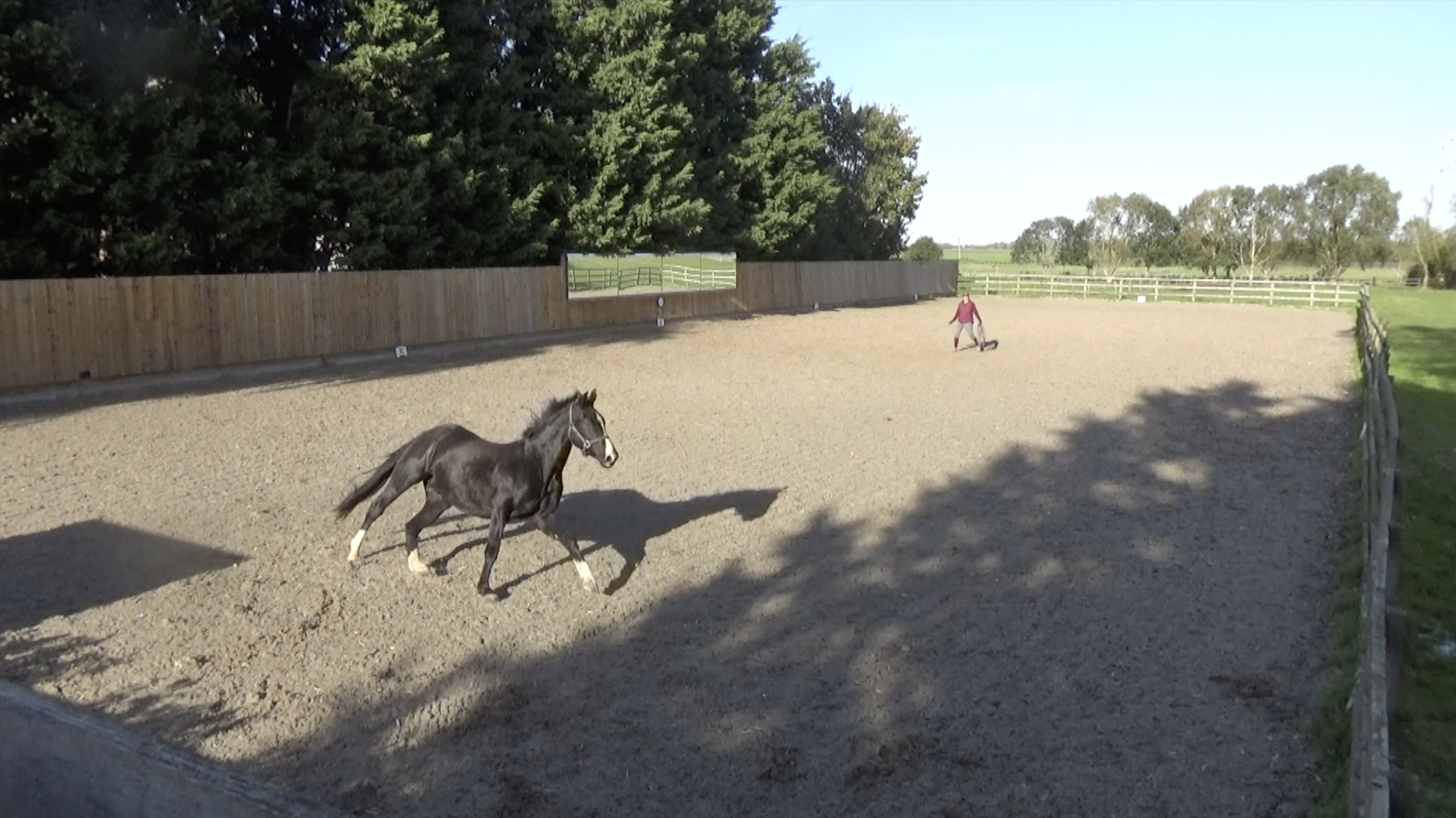
Winter: Lesson 4
Liberty Canter
- Liberty canter
- Lateral bend
- Suppleness
- Reward with rest
- Maintaining
- Balance
- Connection
Working freely in 'liberty' promotes balance, confidence, and fun!
Now this is where the liberty work becomes really useful. When we are cantering we don’t want to be working on endless circles which are hard work for a young horse and puts pressure on the joints which is not good. One major benefit of training in ‘liberty’ is so we can work around the whole arena, using only our subtle 'cues' - it’s like having an ‘Invisible lunge line’ which is an amazing feeling.
Another benefit to having no lunge line attached, is your horse can move freely and find their own balance, which in turn promotes confidence, and the all important relaxation. Build up gradually starting with a few strides, then a quarter circle, then half and then a full circle. Soon your horse will be working beautifully around the arena in canter. The connection you will feel with your horse when you work in this way is an absolute joy!
Downloadable Quick-Reference Cards
Lesson:Shoulder Control

Stand facing your horse, pointing the whip at the shoulder. Open your ‘rope hand’ and tap the shoulder to ‘yield’ one step sideways - ‘tsk’ and reward.

Next, build up the steps turning your horse’s shoulders around the hind. Walk away on a circle to allow time to relax and ‘process’. Repeat on both reins.

Next, set out ‘chevron’ poles with approx 2m gap in between. If your horse has never seen poles before, use ‘targeting’ (Spring season) to familiarise.

Start on a large circle, then walk your horse between the poles to the mid point - then halt using the whip to block, like a ‘window wiper’.

Next, step in front to face your horse and ‘yield’ the shoulder (as learned previously) to turn the corner - then depart. Repeat on both reins.
REMEMBER:
There is a famous saying; ‘To control the shoulders, is to control the horse’. This is a hugely important lesson for your horse to learn.
There is a famous saying; ‘To control the shoulders, is to control the horse’. This is a hugely important lesson for your horse to learn.
- Winter
